What Is Selective Mutism?
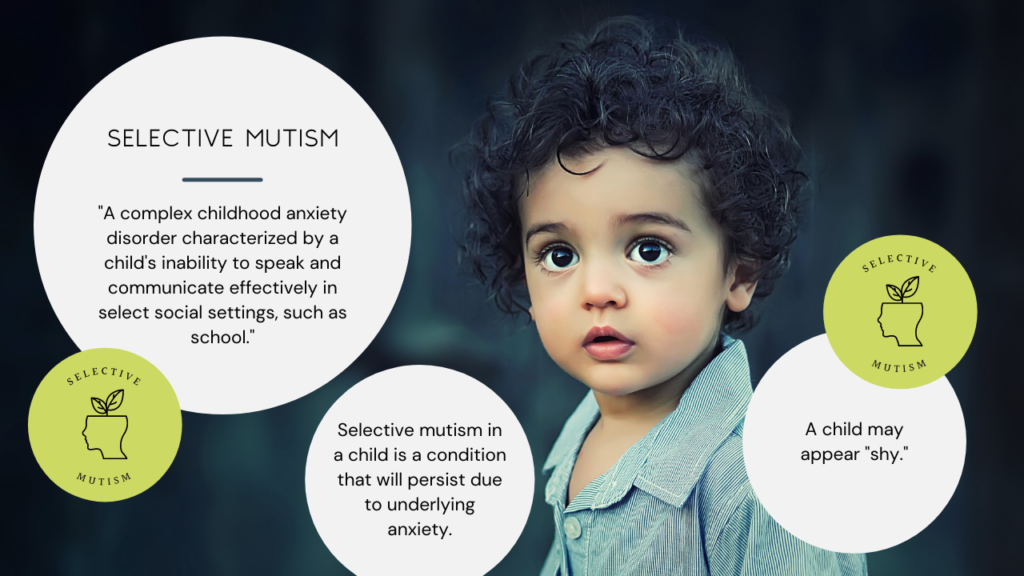
Selective mutism is “a complex childhood anxiety disorder characterized by a child’s inability to speak and communicate effectively in select social settings, such as school. These children are able to speak and communicate in settings where they are comfortable, secure, and relaxed”, according to Dr. E. Shipon-Blum from Selective Mutism, Anxiety & Related Disorders Treatment Center.
Selective Mutism Association characterizes children affected by selective mutism as being able to”...understand language use and, although they have the physical and cognitive ability to speak, they demonstrate a persistent inability to speak in particular settings over a particular period of time due to anxiety.“
Commonly, a child with selective mutism may appear “shy.” However, while shyness is a socially adaptable personality trait, selective mutism in a child is a condition that will persist due to the underlying anxiety and will not disappear by itself without professional help from the selective mutism specialist and the right school and home intervention.
Selective mutism affects a child’s ability to use language in many social settings. Even though the problem may seem to be related to language production on the surface, selective mutism is deeply rooted in anxiety; therefore, the treatment of selective mutism starts with addressing the underlying anxiety.
Read this article about how one family has been overcoming screaming, fear, and crisis.
The overwhelming majority of children with selective mutism also experience social phobia or social anxiety. Because of the compromised social engagement due to social anxiety, selective mutism is quite debilitating and painful.
In addition, it may be accompanied by other developmental delays such as impaired social skills and communication disorders.
Selective Mutism in Children: Causes and Symptoms.
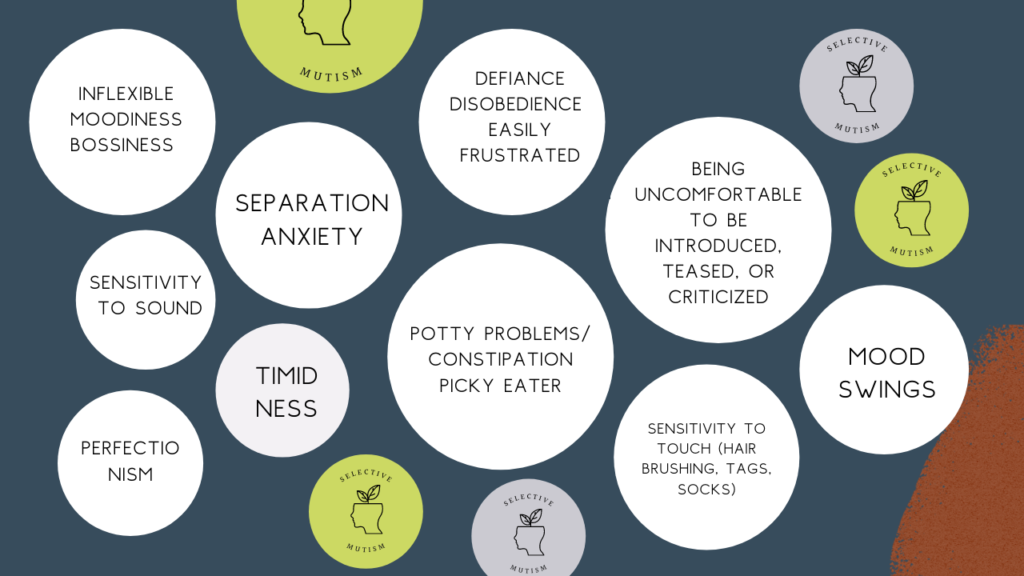
Research says that selective mutism starts before pre-school age (3 years old and up). Very often, the detection and diagnosis of selective mutism occur during the pre-pre school year since this is the first time a child copes with a social setting that is different from a family. Even though pre-school can provide a more specific indication that a child has selective mutism, the condition might be present in a child much earlier than during their pre-school year experience.
There is a list of selective mutism characteristics that can be pretty helpful even for parents in determining selective mutism in children. Based on my family’s experience with selective mutism, this list can be divided into two parts:
1) characteristics detectable before selective mutism exhibits in pre-school, and
2) characteristics visible during the pre-school experience.
A. Before a child enters pre-school or any other social establishment, a parent may notice the following behaviors:
- Timidness
- Separation anxiety
- Being uncomfortable to be introduced, teased, or criticized
- Perfectionism (fear to make mistakes)
- Embarrassment to eat in front of others
- Potty problems/ Constipation
- Picky eater
- Sensitivity to sound
- Sensitivity to touch (hair brushing, tags, socks)
- Defiance
- Disobedience
- Easily frustrated
- Stubbornness
- Inflexible
- Moodiness
- Bossiness
- Assertiveness and domineering behavior at home
- Mood swings
B. When a child enters pre-school or any other social establishment, a parent may notice the following behaviors:
- All the abovementioned +
- Awkward body language
- Lack of eye contact when feeling anxious
- Easily frustrated by school work
- Stubbornness
- Inflexible
- Mood swings
- Procrastination when doing homework
What Causes Selective Mutism?
That’s almost a million-dollar question because if it were possible to know the cause, it would be easier to treat selective mutism.
Literature offers various explanations of selective mutism ranging from theories emphasizing the concept of unresolved conflict to family systems theory. According to the latter,children experience “neurotic” relationships with their parents (most commonly the mother). If you are interested in etiology, Priscilla Wong gives an excellent overview of theories in “Selective Mutism: A Review of Etiology, Comorbidities, and Treatment.”
What Does Selective Mutism Feel Like?
The therapist working with our child often uses the term “bottled up” to describe how kids with selective mutism feel.
I think it’s a great description of the child’s condition. Imagine not speaking for most of your day when you are at work or in any other social setting. Then you will soon realize that you end up with the whole spectrum of emotions stuck inside so that once you have a chance to talk about them, it comes out as anger and frustration.
Get all the information important for a parent in one place – “Selective Mutism Parents Guide.“
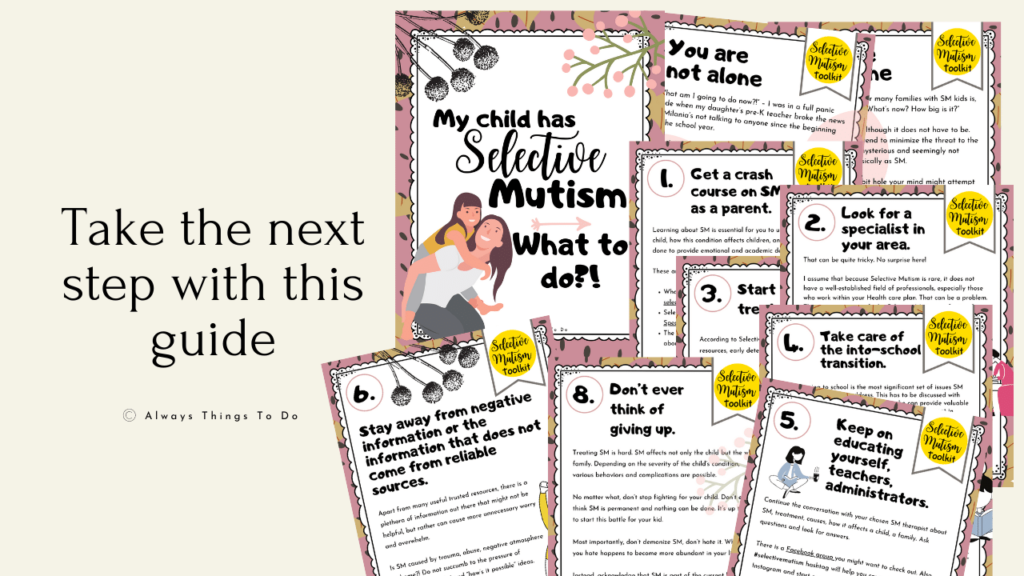
Is Selective Mutism a Rare Genetic Anxiety Disorder?
According to the National Organization for Rare Disorders, selective mutism is rare since it’s found in less than 1% of children. Like any other mental condition (depression, anxiety disorders, eating disorders and addictive behaviors, etc.), selective mutism is categorized as a mental illness. It is not a choice an individual makes about speaking or not speaking.
The exact cause of selective mutism is unknown, and the research in selective mutism mentions a plethora of conditions and predispositions that cause selective mutism in a child. Among those conditions are genetic influence, environmental factors, personal and family characteristics, and many others.
Since the research on selective mutism is scarce, it’s generally accepted that selective mutism causes are relatively unknown and hard to pinpoint.
Children affected by selective mutism display anxiety disorder in various ways: some children have more severe symptoms, others have “mild” symptoms.
Even though the causes of selective mutism are not due to the underlying physical abnormality, selective mutism is considered to be a disability since it is characterized as a persistent failure to speak in certain social situations (e.g., school, with playmates) where speaking is expected.
When undiagnosed and/ or untreated, selective mutism can culminate in other debilitating conditions and consequences such as:
- Worsening anxiety
- Depression and manifestations of other anxiety disorders
- Social isolation
- Low self-esteem
- Academic difficulties
- Drugs or alcohol abuse
- Suicidal thoughts
Many other mental and neuropsychiatric disorders have symptoms similar to those of selective mutism. Among the similar conditions to those of selective mutism are aphasia, autism, and others. Extensive medical evaluation and diagnosis are the key to determining whether a child has selective mutism or another disability.
Finally, it’s hard to describe selective mutism as a curable condition. However, with a timely diagnosis, behavior management, cognitive behavioral therapy and family therapy, and medication, children with selective mutism can tackle the worst symptoms of selective mutism can thrive as individuals.
How is Selective Mutism Diagnosed and Treated?
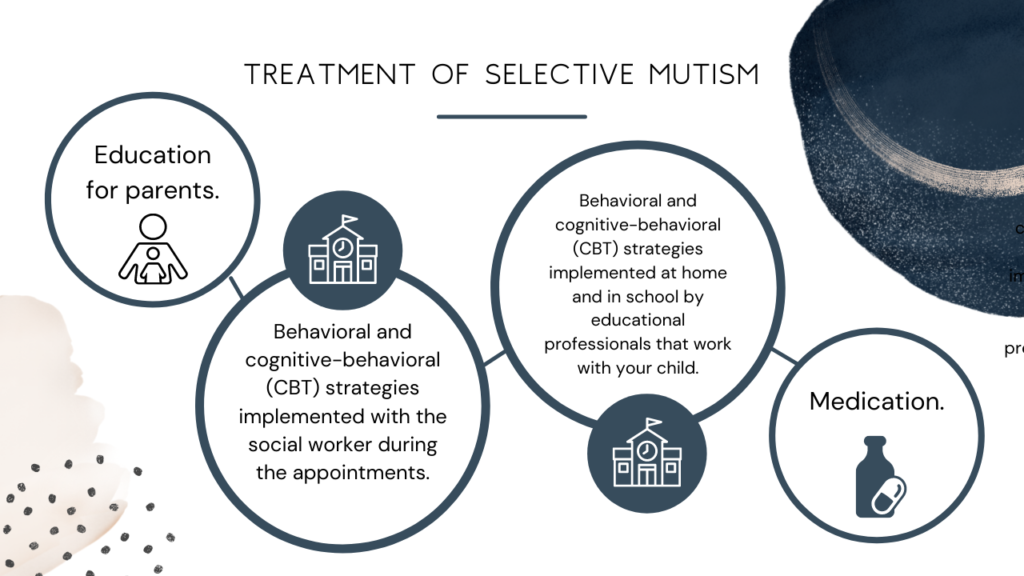
Even though my own child had symptoms of selective mutism much earlier than four years old (and I know about it only now), we haven’t started treatment for selective mutism because we did not realize those specific symptoms indicated selective mutism.
The giant red flag appeared when my daughter started pre-school, and the teacher noticed she hadn’t spoken to the teacher or peers for more than a month.
It was something beyond shyness or a regular kid’s behavior when adapting to the new routine and environment. Once I researched the initial information online, I started looking for a specialist in selective mutism to begin with the treatment plan.
Treatment for selective mutism starts with a proper diagnosis. It is usually done by a licensed clinical social worker, preferably the one who has experience in treating children with selective mutism. Why does it matter? It does because, first of all, selective mutism is a rare disorder, and second, some of the symptoms related to selective mutism may be easily misinterpreted for something else.
The Selective Mutism Association provides a good list of treating professionals in many states in the US and beyond. Finding a specialist in your state and your area is the next logical step.
Next, contact your health care provider to find out if the treatment is covered. Unfortunately, it is often not covered, or the specialist you will be working with does not accept the health plan you have.
Once you find the professional to work with, the treatment of selective mutism, in my opinion, is divided into four parts:
- Educational.
- Behavioral and cognitive-behavioral (CBT) strategies implemented with the social worker during the appointments.
- Behavioral and cognitive-behavioral (CBT) strategies implemented at home and in school by educational professionals that work with your child.
- Medication
As for the first step, it’s a parent’s responsibility to get to know as much as possible about selective mutism. Some basic information can be found on the websites of the Selective Mutism Association and the Selective Mutism, Anxiety and Related Disorders Treatment Center (SMart Center).
Treating selective mutism in a child further continues with the clinical social worker.
During the first appointment, the selective mutism treatment professional will ask parents questions related to the child’s behavior and family history of anxiety disorders. During the subsequent visit, the treatment professional will meet with the child. The diagnosis will be made based on the information provided by parents and the selective mutism treatment professional’s observations of the child.
Typically, the treating psychologist has a conversation with parents about behavioral and cognitive-behavioral (CBT) strategies used during treatment sessions. Most importantly, the psychologist can provide information to parents about the strategies to implement at home.
The medication step may come in combination with the cognitive-behavioral (CBT) strategies used in the treatment. The selective mutism treatment professional usually recommends a psychiatrist who will evaluate the child and prescribe medication.
Even though the medication step may seem a scary and unwanted route, the decision about this step should be taken collectively with the selective mutism treatment professional and parents. Medication might be necessary if a child’s condition does not improve, the child plateaus in his/her progress to speak, or when the social anxiety aspect of selective mutism impacts the child’s wellbeing.
Interventions For Selective Mutism in a School.
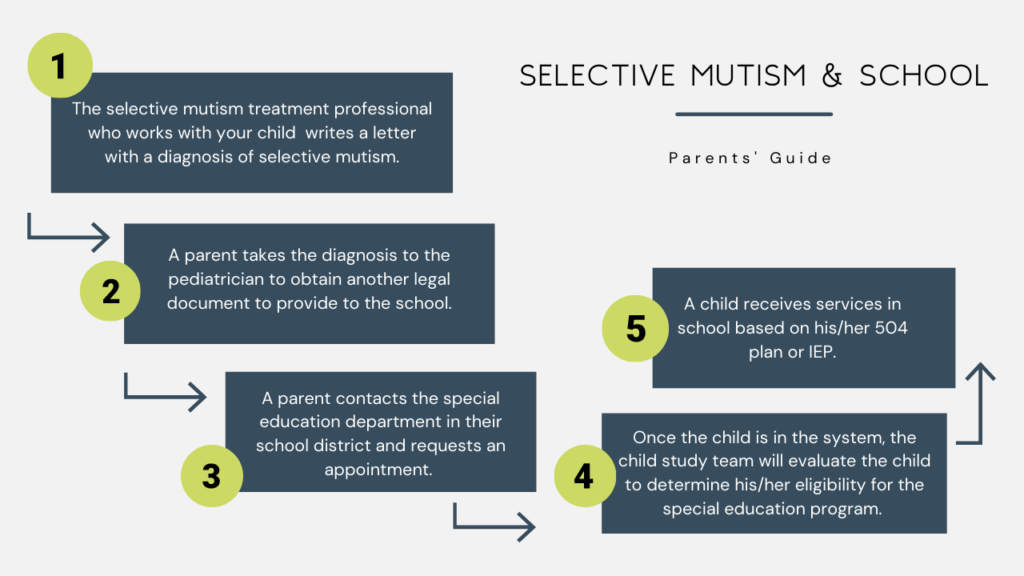
An extensive overview of teacher’s possible support of a child with selective mutism is provided by the Child Mind Institute. Check out their teachers guide to selective mutism. The Selective Mutism Association also has some great resources for educators, parents as well as treating professionals. One more source worthy of exploring is the Selective Mutism, Anxiety and Related Disorders Treatment Center (SMart Center).
In a nutshell, whether selective mutism condition is addressed in a school will depend on the parent’s involvement. Your selective mutism treating professional is an invaluable source of information about what steps need to be taken for the parent to let the school know about the diagnosis and to request further accommodations.
For the parent, this journey may look like this:
- The selective mutism treatment professional who works with your child will write a letter with a diagnosis of selective mutism.
- A parent takes this letter to the pediatrician to obtain another legal document to provide to the school.
- A parent contacts the special education department in their school district and requests an appointment.
- Once the child is in the system, the child study team will evaluate the child to determine his/her eligibility for the special education program.
It will depend on the district and the availability of the funding whether your child will receive special services. The eligibility for special services may range from a child getting a 504 plan to an IEP plan.
If the child received an IEP, usually it means that a child will be working with the special education teacher who pulls out the kids for ELA and Math classes. In addition, the child might get speech therapy and other social-emotional support in school (ex.: friends groups, etc.).
While a child receiving an IEP at school is a huge win for parents in providing their child with the support for his/her education, parent initiative, persistence, and involvement with the child’s teacher is a huge factor in the success of school interventions.
Please, work with your selective mutism treatment professional to get ideas about building communication and relationships with the classroom teacher to implement selective mutism targeting strategies in a classroom successfully.
Daily communication with the classroom general education teacher, the special education teacher, or any other school professional is essential for your child’s success in overcoming selective mutism at school.
You may find this book helpful to start with: “The Ideal Classroom for the Selectively Mute Child: A Guide for Parents, Teachers, and Treatment Professionals” by Elisa Shipon-Blum. Get the copy for yourself and the teacher of your child.
Finally, if your child gets an IEP, it’s essential to be on top of the goals the school professionals include in your child’s individual educational plan to make sure the goals are geared explicitly towards selective mutism and your child’s case.
The Selective Mutism Association has a beneficial section on Education Planning, IEP, IDEA, and 504. Their 504 plan suggestions give an excellent overview of goals specifically geared toward selective mutism.
Remember, the school professional does not necessarily have knowledge let alone experience, of working with children affected by selective mutism. Therefore, as a parent, your goal is to advocate for your child’s education and proper interventions.
Selective mutism treatment might seem like an overwhelming journey, and it is sometimes. Keep in mind is that the success of your child’s overcoming selective mutism will depend on many factors such as good selective mutism treatment professionals, parents’ educating themselves about selective mutism, a child receiving a 504 or IEP plan in school.
In the end, remember that selective mutism is rooted in anxiety. All the interventions and therapy will not target speaking problems directly, but they will target anxiety. And once the anxiety of the child is lowered, then success in overcoming selective mutism is possible.
Get all the important information in one place – “Selective Mutism Parents Guide.“
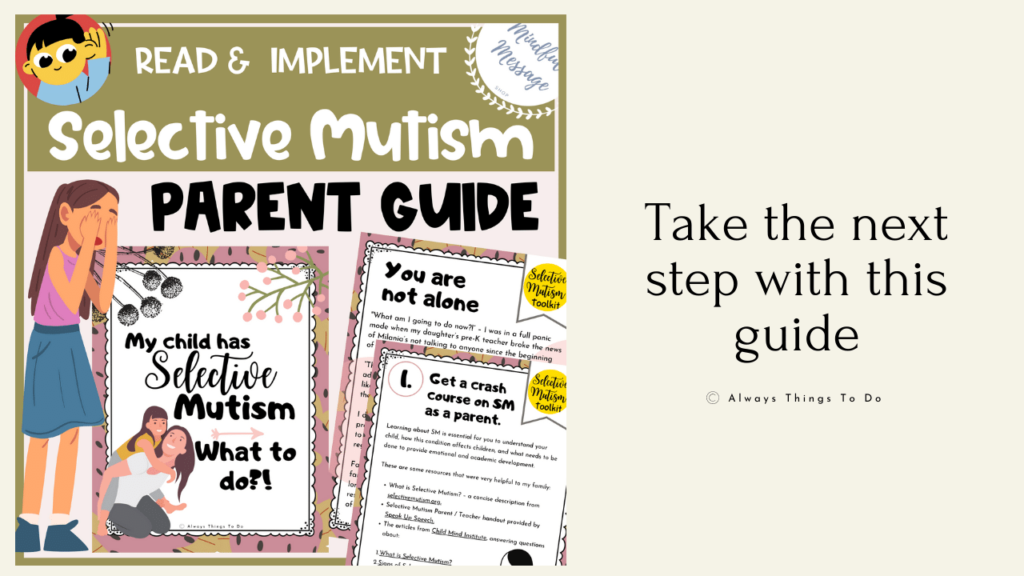
If you liked the information in this post, make sure you explore other posts about selective mutism:
- “Selective Mutism: How To Beat Crisis, Screaming, and Fear.”
- Diagnosis of Selective Mutism: Simple Parent Guide and Steps to Take.
- What Are The Causes of Selective Mutism?
- Is Selective Mutism a Disability?
- How Do You Treat Selective Mutism?
- 70 Selective Mutsim Symptoms & 3 Diagnostic Criteria.
- Selective Mutism Myths: Most Common Concerns Addressed.
- Selective Mutism Classroom Accommodations: What You Need To Know About 504 and IEP.
STAY CONNECTED:
- I’m a mom to Milania and Luka. I’m also an educator, and I create resources for classroom learning.
- To explore the social-emotional learning/mindfulness activities, worksheets, and other resources for a classroom, stop by the Mindful Message Shop.
- Hang out with me on my Instagram @alwaysthingstodo.
Don’t forget to stay in touch!
Talk to you later!
Yanina.



